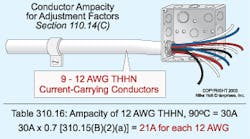When you find yourself stumped by the Code, just e-mail your question to [email protected] or visit www.mikeholt.com. Your question and Mike's answer may be posted in a future Code Q&A column.
Q. I’m working on a job that includes a raceway with nine 12 AWG current-carrying conductors. What’s the ampacity of these conductors—after conductor ampacity adjustment—as required by Table 310.15(B)(2)(a) in the Code? It’s my understanding that you must take the amperage of 12 THHN as listed in Table 310.16 under the 90°C column, which is 30A. I multiplied this value by 70%, yielding an ampacity of 21A, which may be placed on a 20A breaker.
My boss instructed me to use the 20A rating of the circuit breaker, which results in the conductor having an ampacity of 14A. Based on this interpretation, this conductor can’t be placed on a 20A circuit. Who is correct?
A. You are. The ampacity after conductor adjustment for 12 AWG THHN conductors in a dry location is based on 30A rating as listed in Table 310.16 under the 90C column [110.14(C)]. Therefore, you can place this 21A conductor on a 20A protection device.





